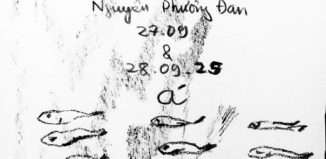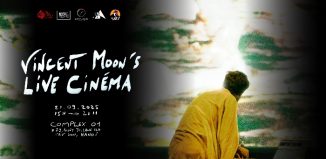KVT – A Symphony Honoring Dien Bien Phu


KVT and the WOW factor with the VNSO
As I approached the Opera House on Wednesday night the scent of Hoa Sua flowers drifted through the surrounding streets and I knew that we were in for a special performance from the Vietnam National Symphony Orchestra.
Very occasionally you are lucky enough to be part of what I call the WOW factor. And the VNSO swirled in it for about 30 minutes when they played the world premiere of a symphony composed especially for them in honor of the 60th anniversary of the world shattering Vietminh victory over the French at Dien Bien Phu.

World shattering because the victory showed other colonially dominated people that the big boys weren’t invincible and that started a trickle that became a flood as the oppressed began to cast off the shackles of European imperialism.
Diminutive, 74 year old Viet Kieu, Nguyen Thien Dao, did the anniversary proud with his Symphony Rendezvous which is an excellent example of his merging of western contemporary classical music and Vietnamese music which he began in the 1990ies when he became acquainted with the new music emerging in Vietnam. He was born in Hanoi and went to France when he was 13 and was a teenager there when the battles of Dien Bien Phu took place. He studied composition with Olivier Messiaen and his work is well regarded in European classical music circles.

A few days before the concert I’d been motor biking the Ho Chi Minh Trail between Khe San and Phong Nha. It was clear, cool weather and as we traveled through densely jungled mountains, accompanied by eddies of white and yellow butterflies, with subtle spring flower perfumes descending in invisible, alluring veils, cicadas began to play their shimmering, shivery tunes, different families adding different pitches and notes.
What started with a low murmur swelled to encompass sun spangled forests until the sound was deafening…shrill. Suddenly this Symphony of the Cicadas would burst to a halt and the silence was deafening…..and then a new movement would slowly commence building in intensity until the valleys that spread below were engulfed..

At one stage we climbed through drifts of clouds and into a fog dense with thunder that pounded over the trembling symphony still echoing far below
The Symphony Rendezvous would perfectly fit into the scenario that was Dien Bien Phu. Not the thundering cannons and explosions that were the battlefields, but the hundreds of kilometers of stifling, slippery jungle slopes that the Vietminh and their ethnic comrades had to push and strain to get heavy artillery and supplies to the mountain tops that surrounded Dien Bien Phu and from which they gained a decisive advantage over demoralized French forces. As they pushed and pulled and sweated or shivered with cold the various cicada symphonies would, at times, have soared along with them


My only response as symphony concluded was WOW!
Congratulations conductor Honna and your players for 30 minutes to remember.
The first offering of the evening was a tone poem for orchestra and violin by French composer Ernest Chausson, first played publicly in 1896. As an accompaniment to the Symphony Rendezvous it worked beautifully as it was almost a threnody, a lamentation for the dead. Not that Chausson imagined it to be interpreted as such, but its quiet beauty and its impassioned passages allowed my mind read it that way. It’s the sort of music that could be played over dead and wounded young soldiers as they lie in the mud of battlefields as a lamentation for lives not allowed to be emotionally fulfilled.
Reviewing a performance of the Poème in 1913, Debussy said of the quiet close that nothing could be “more touching than its gentle dreaminess . . . where, casting aside any ideas of description or narrative, the music itself is the sentiment that commands our feelings. . . . Fine music this, and full of ardor.”
Local violinist, Bui Cong Duy, gave us a playing that brought the Poeme’s pathos to the fore and made riveting listening.

Beethoven’s ‘Eroica’ rounded off the night and most of the audience preferred its luscious well known tunes to the atonal work of Nguyen Then Dao’
I like to think that the symphony was chosen to honor the mastermind of the victory, General Vo Nguyen Giap.
Initially Beethoven dedicated the symphony to Napoleon as a hero of change and revolution and a new European order. He thought he recognized in Napoleon a hero of the people and a champion of freedom But he changed all that when Bonaparte had himself proclaimed Emperor and maintained a lot that was pretty rotten to the core.
I think he’d have approved of honoring the young Giap, a hero of the people and a champion of freedom, with this work, as he showed the world that he was a military genius on Napolean’s level executing battles against the French, Americans and Chinese.

One has to wonder where Vietnam would be now if Giap had been Ho Chi Minh’s natural successor to power…and if, as in Napoleon’s case, absolute power…………!
In this symphony Beethoven began to use broad strokes of sound to tell us how he felt, and what being alive meant to him (he knew he was going deaf when he composed it) The piece caused a sensation and changed the idea of what a symphony could be.
The VNSO gave a really nice interpretation of the symphony that, in its final movement (as one Beethovenphile puts it….it gives us a suggestion of that moment in life when we look at something or someone we’ve always taken for granted with new eyes and realized just how special they are.
BUT IT WAS THE WOW OF NGUYEN THIEN DAO’S WORLD PREMIERE THAT MADE THE NIGHT FOR ME TOTALLY AND UNCONDITIONALLY WOW.
PLEASE MR HONNA MAY WE HEAR IT AGAIN? SOON?

| Kiem Van Tim is a keen observer of life in general and the Hanoi cultural scene in particular and offers some of these observations to the Grapevine. KVT insists that these observations and opinion pieces are not critical reviews. Please see our Comment Guidelines / Moderation Policy and add your thoughts in the comment field below. |













